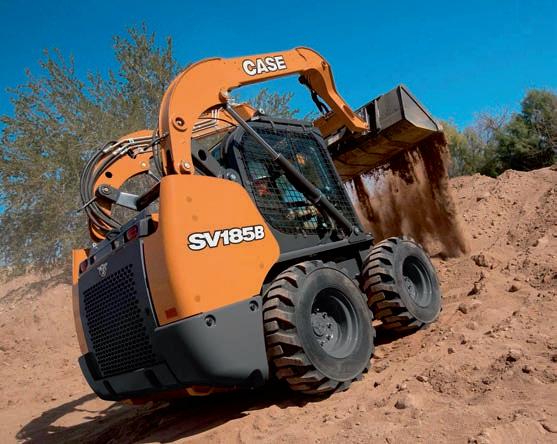
3 minute read
Case launches track loader and skid steer range
big case load
Case Construction
Equipment has launched its B Series of compact track loaders and skid steers
Above: The SV185B skid steer loader
Comprising eight skid steers from 49-90 horsepower and five compact track loaders from 74-90hp, the new B series spans a range of sizes and radial and vertical lift patterns, giving contractors a wide variety to choose from.
“Case CTLs [compact track loaders] and skid steers are enhanced to deliver a completely new and intuitive operating experience while also standing up to the rigours of heavy earthmoving and attachment use,” Case Construction Equipment ANZ product manager Jim Pike says.
“The B Series retains the styling of previous Case loaders, yet critical operational systems have been re-engineered for greater performance, and fully integrated with new control and operator interfaces to give contractors a powerful match of productivity, efficiency and convenience.”
IN THE CAB
New Case B Series loaders feature a completely redesigned operator interface, including new left- and right-hand posts with simple ignition, push-button operation, easy throttle control and intuitive switches for all core machine functions.
Contractors may choose between standard mechanical, mechanical hand-and-foot, and electro-hydraulic controls when specifying a machine.
An all-new eight-inch (20cm) LCD multi-function display with backup camera comes with all electro-hydraulic models — and it can be added to mechanical configurations for use with the backup camera and operational displays (but without the electro-hydraulic control capabilities).
Electro-hydraulic models provide the additional simplicity of switching between ISO and H operating patterns with the simple push of a button.
A new ‘creep speed’ capability allows the operator to set machine speed at a consistent/ slow ‘creep’ while independently setting attachment speed via the throttle for optimal use of high-capacity hydraulic attachments such as cold planers and brooms.
FOCUS ON COMFORT
The low entry threshold built into each machine allows for easy entry and exit from the cab. Case features one of the widest skid steer and CTL cabs in the industry, providing excellent space for more comfort and operator positioning, it says.
Joysticks on electro-hydraulic models have been designed with a narrower, more comfortable grip, and closer switch layout and a smaller head size for easier operation. The electro-hydraulic pods on each joystick have also been made smaller to give the operator more legroom inside the machine.
Mechanically controlled models of the SR210B and larger models also feature servo-assisted joysticks for easier operation and less operator fatigue.
As it relates to attachment use, the Case B Series provides either standard, high-flow or enhanced high-flow auxiliary hydraulics with pressures up to 4,000 psi for running highcapacity hydraulic attachments such as cold planers and mulchers. All models additionally feature a ‘connect under pressure’ manifold design that allows for quick and toolless removal of hydraulic lines.
EMISSIONS AND MAINTENACE
On the maintenance side, new fault codes with descriptive text help better identify specific issues the machine may be going through and make it easier to communicate with the dealer to determine next steps, if necessary.
B Series models (except the SR130B & SR160B) feature either a cooled exhaust gas recirculation (CEGR) design with a diesel oxidation catalyst that requires no fluids or lifetime filter maintenance, or a CEGR design with selective catalytic reduction after-treatment (on 90 horsepower [67kW] units) that also requires no lifetime filter maintenance. This provides better fuel economy and more horsepower per litre when compared against other methods of after treatment.
Daily checks on all models are simple, with all regular service points and checks easily grouped at the rear of the machine.










